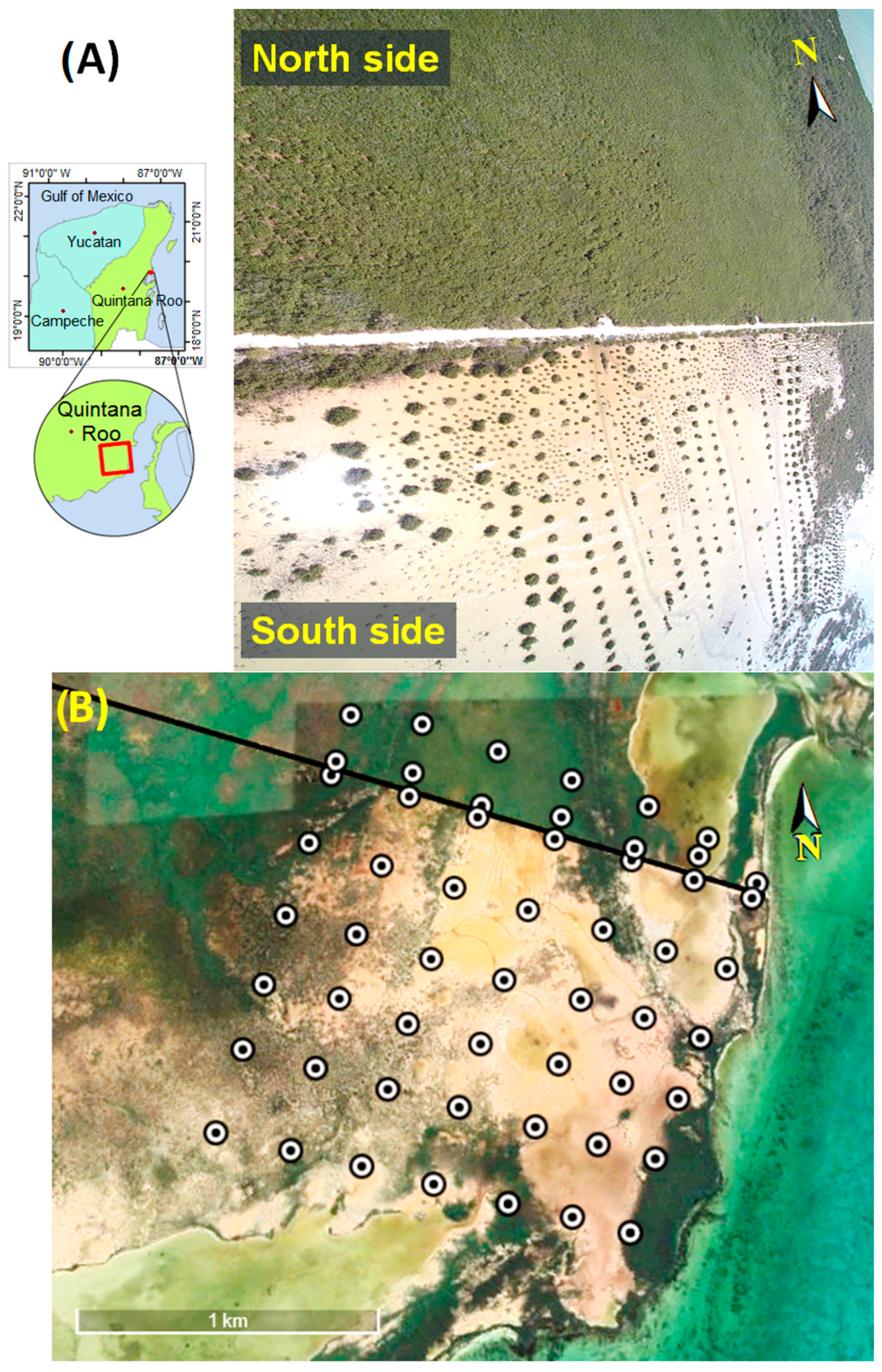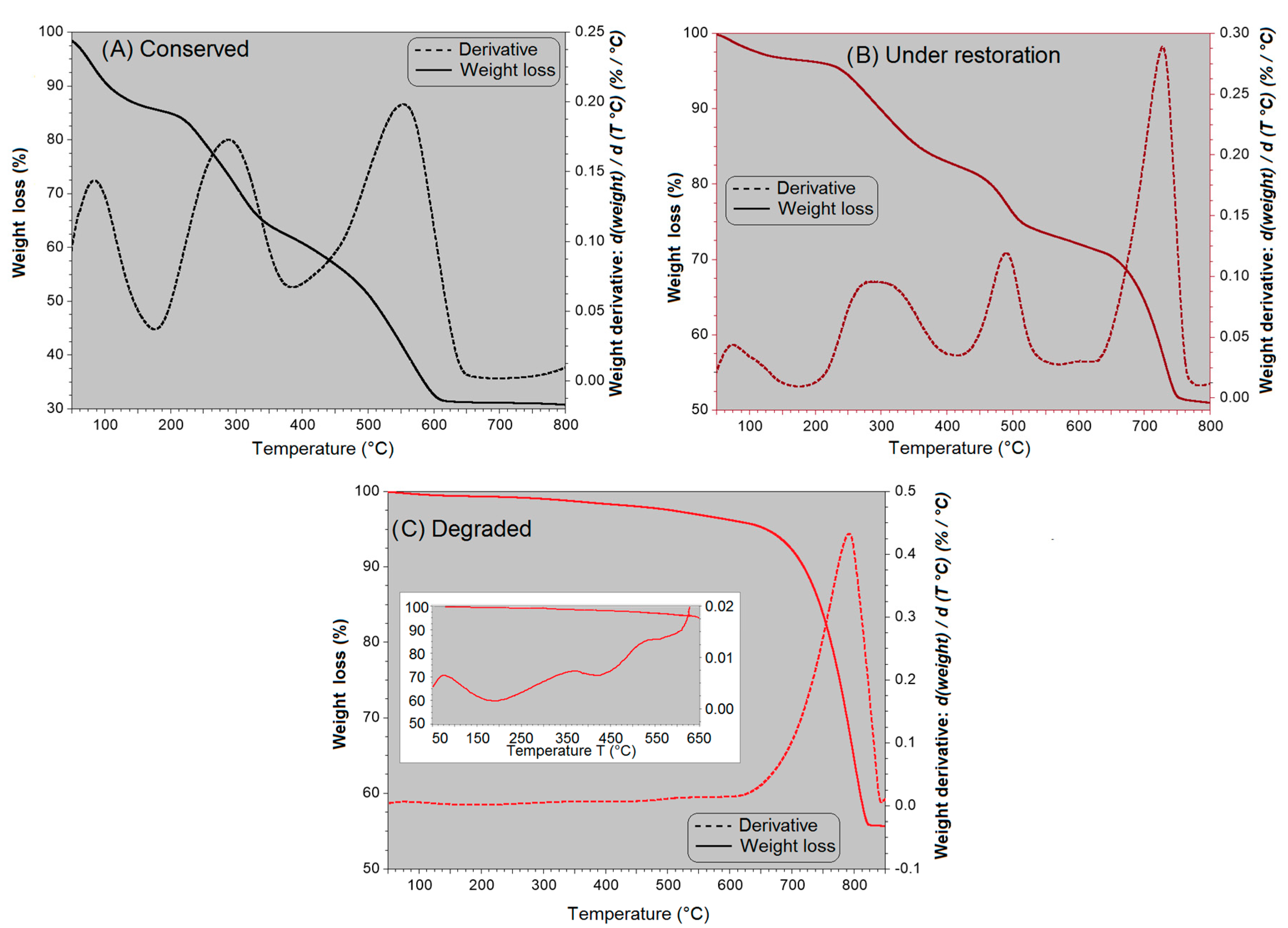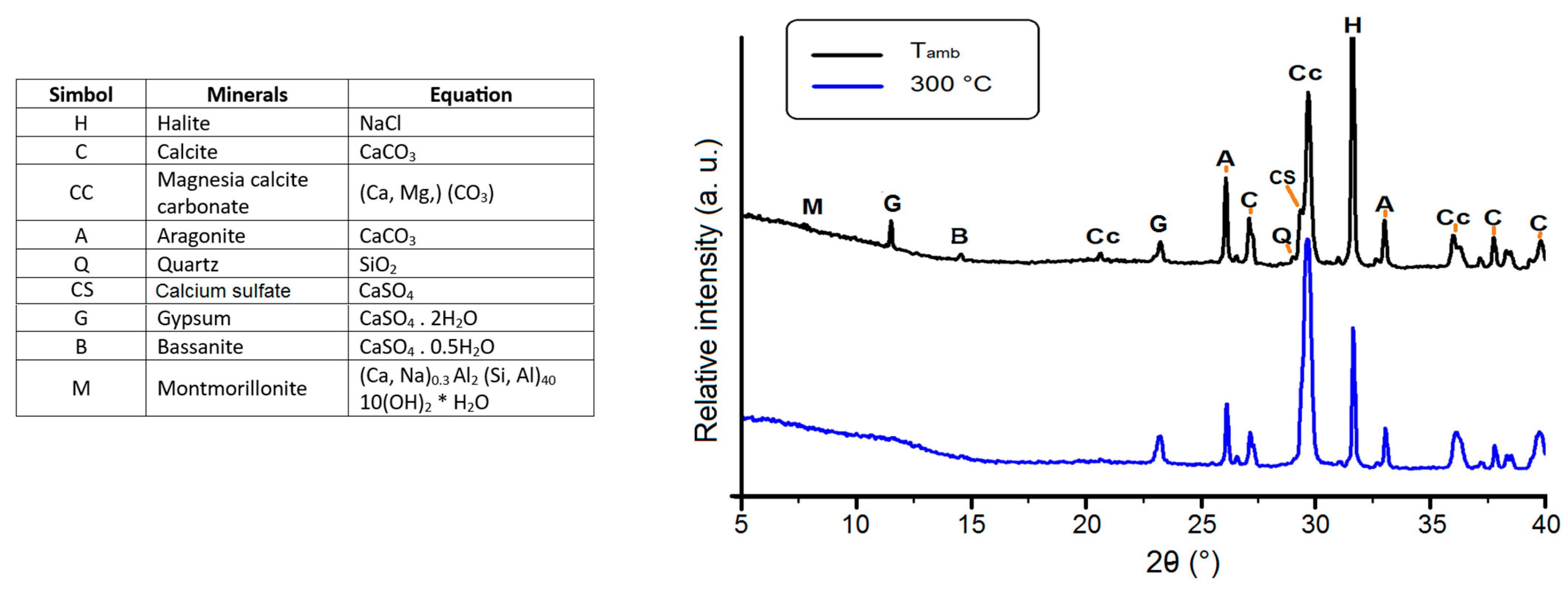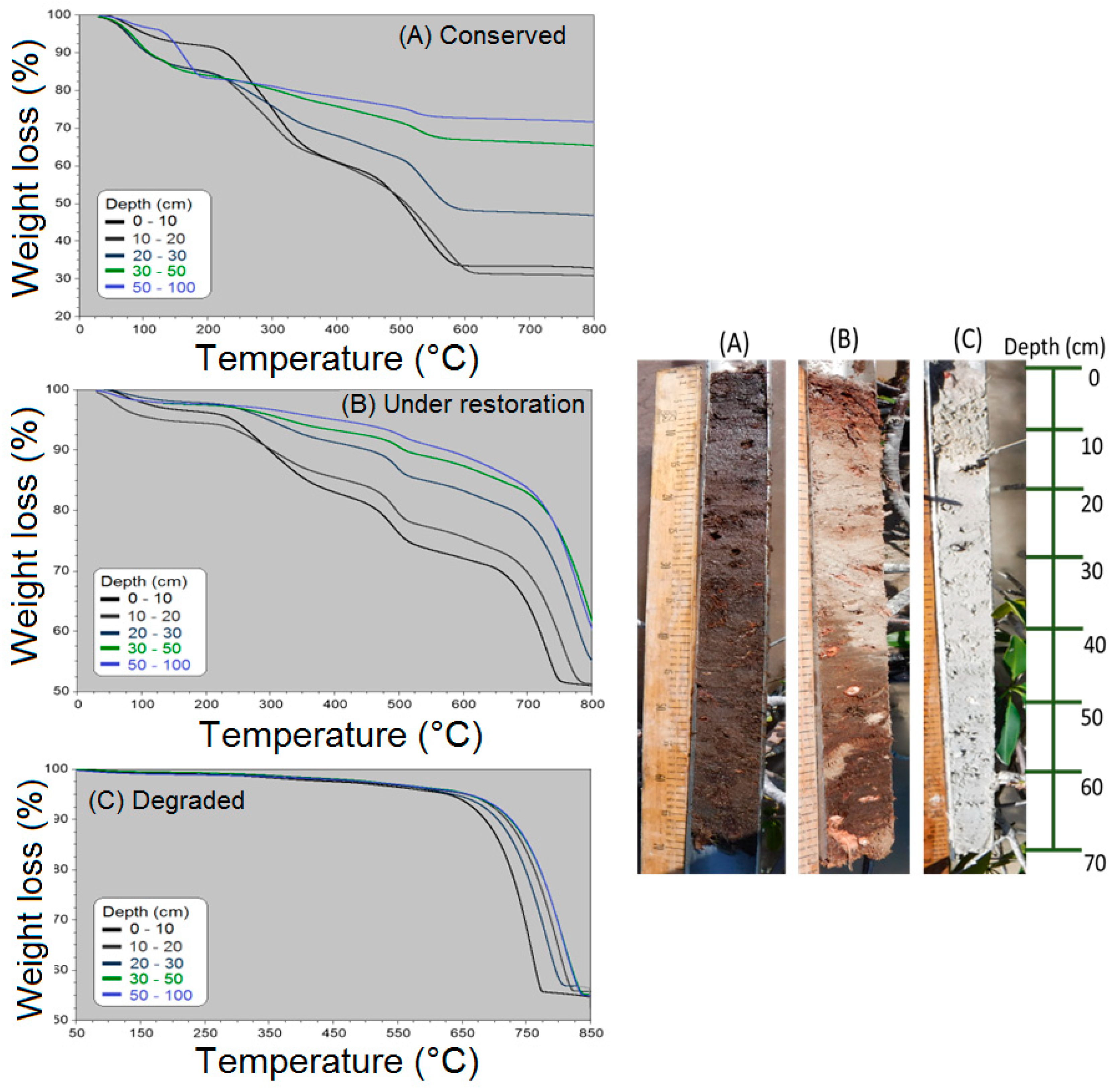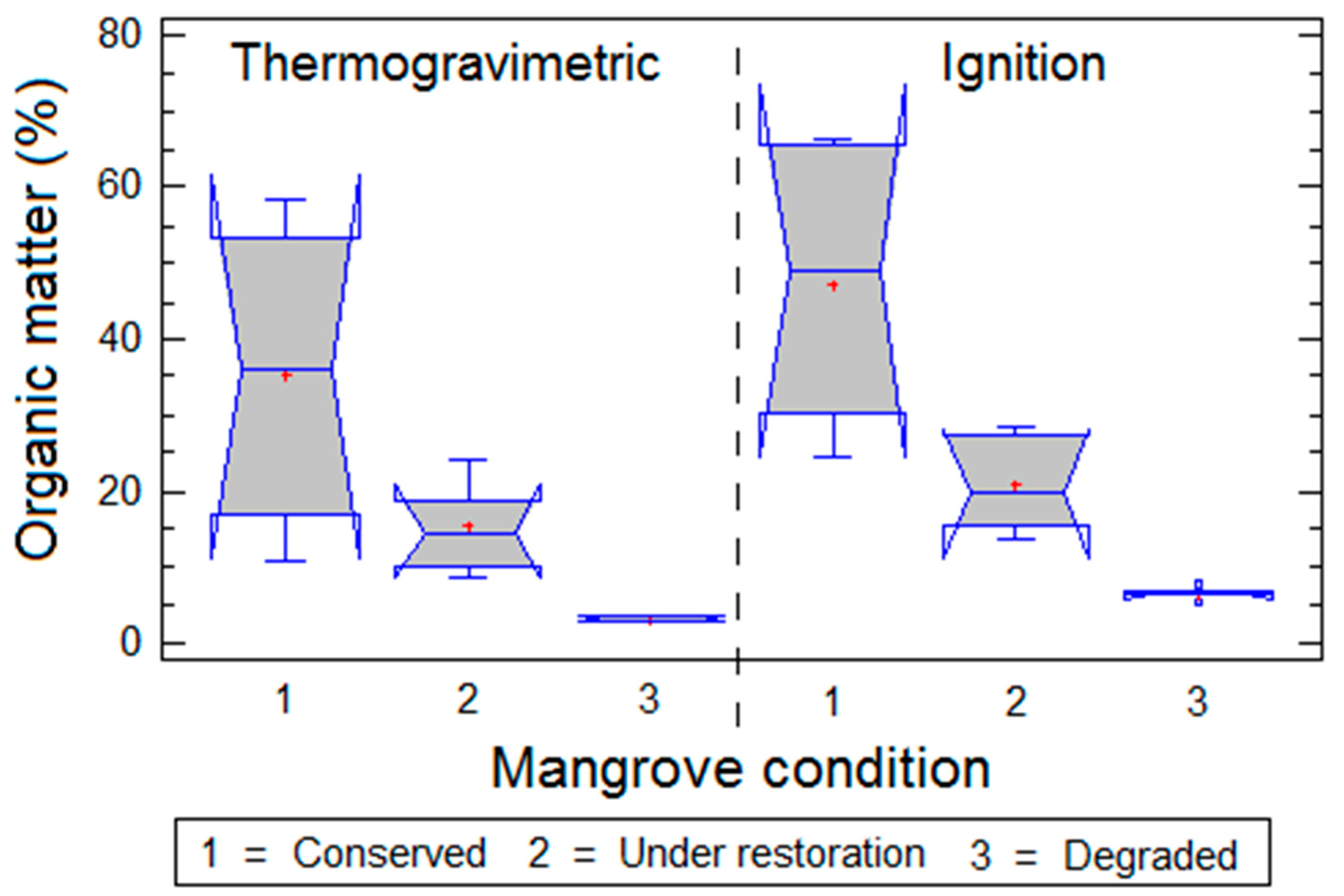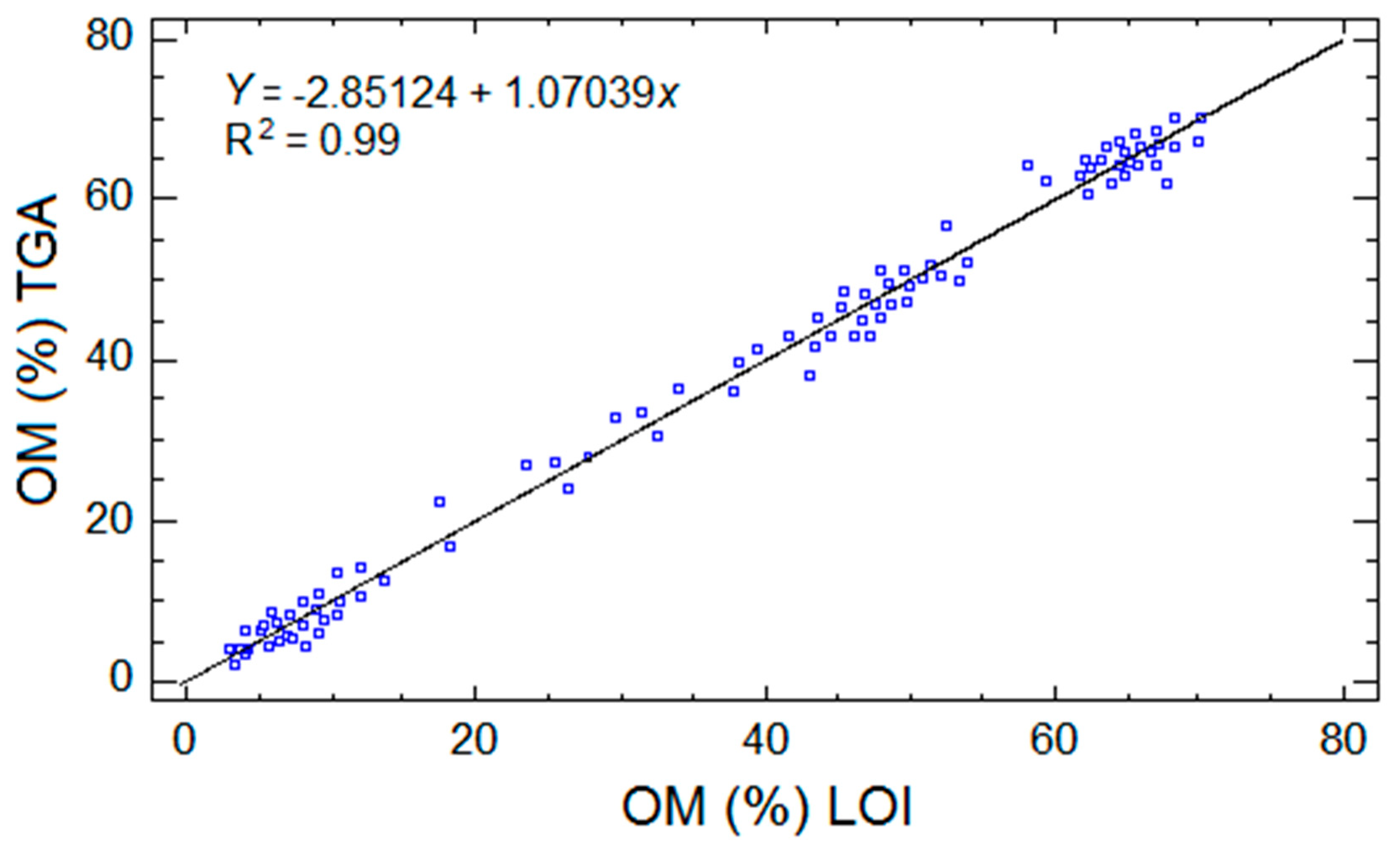1. Introduction
Soil is a natural body found on the Earth’s surface. Today, it is considered an ecosystem by itself since it shows all the necessary components for the proper development of life (nutrients, minerals, water, air, and organic material) [
1]. The edaphogenic characteristics of soils are controlled by soil-forming factors, including the parent rock from which the soil is formed and the climate, relief, and biota, all depending on time and human management [
2,
3,
4].
One of the main characteristics of soil is that the minerals and nutrients that make up the entire profile are mainly obtained from the bedrock at the site where the soil was formed. To a lesser extent, minerals and nutrients are naturally deposited on the soil following their erosion from nearby sites, which also helps to incorporate the remaining available nutrients that are present in plants and organisms [
5,
6].
One of the most studied components of soil is its organic matter (OM) content. It has been estimated that around 58% of OM is mainly organic carbon [
7], which, when entering the soil, leads to carbon storage in the soil. One of the priority issues for the scientific community and governments is identifying natural ecosystems that allow the storage of carbon in the soil for long periods of time to help mitigate greenhouse gas emissions that are contributing to the adverse consequences of climate change. Addressing this issue will reduce the vulnerability of populations in general and the ecosystem services that mangroves provide [
8].
Mangroves are tropical ecosystems in coastal areas that provide multiple ecosystem services such as protection against strong waves and high tides, thus acting as a barrier against hurricanes and a nursery area for various species of fauna. They are also carbon sinks over periods of time, ranging from several years to thousands or millions of years [
9]. This is favored by the anoxic conditions in these wetlands, which are submitted to a long period of flooding. This means that the organisms that influence the oxidation of OM cannot perform rapid decomposition, thus accumulating high concentrations of OM and promoting carbon storage for long periods of time in mangrove soils [
10,
11].
Mexico ranks fourth in the world in terms of its mangrove area, following behind Indonesia, Australia, and Brazil [
12]. The Yucatan Peninsula (YP) occupies 60% of the surface of this region. In relation to mangrove soils in the YP, they are characterized by a calcite content between 89 and 99%, the main compound being calcium carbonate (CaCO
3), while the rest of its minerals are quartz, clay, and iron oxides, whose concentrations, in many cases, are less than 4% [
13]. However, the edaphogenic characteristics of mangrove soils in the Yucatan Peninsula are very particular because the formation of soils in this ecosystem is not directly related to the bedrock on which they develop. Rather, there is a group of factors that make the soils unique, as follows: (a) The YP is a karstic geomorphological region, which causes the aquifers to be internal; these are formed from the dissolution of limestone, where the minerals and nutrients are transported and deposited on the coast [
14,
15,
16]. (b) Part of the hydrological flow in the mangroves comes from marine currents, which also contribute minerals that remain captured in coastal ecosystems [
17]. (c) The physiological characteristics of mangroves, including prominent roots, allow the retention of minerals and nutrients that reach the ecosystem [
4]. Transported minerals are essential for the capture and storage of OM since minerals such as clays and quartz encapsulate OM particles, coupled with periods of flooding and anoxic conditions within mangroves [
18].
At present, one of the soil characteristics that is regularly measured is the OM content, the most common method being weight loss on ignition [
19]. However, this method can overestimate results for mangrove soils that have a direct hydric influence since some minerals can retain water in their internal structure, which only evaporates at high temperatures. These features do not occur in volcanic soils or in soils without the influence of water. For this reason, it is necessary to search for other methods and procedures that reduce this uncertainty since, by overestimating the OM content, the content of organic carbon stored in these ecosystems might also be overestimated. National reports on the potential mitigation of CO
2 emissions using the conservation and/or restoration of mangroves are uncertain, which has consequences for the strategies and policies that are implemented in these ecosystems [
9,
11,
20].
At present, new techniques have been proposed for the determination of the OM content in soils, which can achieve high precision in their measurements [
20,
21]. Since they contain high percentages of inorganic carbon, the soils in karstic environments must undergo a prior treatment that, in some cases, can lose a portion of the OM. In other cases, the equipment is extremely expensive, and the analysis is time-consuming. Therefore, it is necessary to search for other efficient measurement tools that can return accurate results in a shorter time. A technique that has not yet been widely explored is thermogravimetric analysis [
22]. The advantage of this approach is that it allows the characterization of materials and compounds in terms of decomposition rates (incineration), evaporation, and oxidation, among others, after a constant thermal treatment increase as a function of time and temperature. This technique also allows researchers to observe, in real time, the evolution of material decomposition [
23]. Therefore, this method could be used to quantitatively determine the OM content in mangrove soils.
The objective of this work was to determine and compare the OM content in mangrove soils from a karstic geomorphological environment in the Yucatan Peninsula, Mexico, using two different techniques, namely loss on ignition (LOI) and thermogravimetric analysis (TGA).
Additionally, this study aimed to identify hydrated calcium sulfates in mangrove soils with X-ray diffraction (DRX) before and after subjecting them to different temperatures, using the TGA technique to observe the presence and/or absence of these minerals.
For the LOI technique, we hypothesized that an overestimation of the OM content will be observed since this technique incorporates the amount of water from the internal structure of hydrated sulfates that are found naturally in soils with a hydrological influence. This water cannot be ruled out because the samples are subjected to a constant temperature for a certain time, meaning the processes that occur during the measurement time cannot be differentiated. In contrast, when using TGA, the amount of water and OM can be identified and accurately quantified in real time.
In addition to TGA, XRD analysis helps in the mineralogical identification of soil and thereby enables researchers to verify or rule out the presence of hydrated calcium sulfates in soil samples when subjected to different temperatures. Both techniques are highly accurate, and the measurement times are relatively short, taking into account the importance of obtaining the OM content to estimate the organic carbon in mangrove forests.
It is worth mentioning that both the LOI and TGA methods have the same analytical principle, where the samples are heated to a certain temperature to evaporate or burn the OM within them. However, TGA allows for measuring the weight loss of different minerals individually since each datum is recorded with a thermogram as the temperature increases.
2. Materials and Methods
2.1. Study Area
El Playón is a site located in the Sian Ka’an Biosphere Reserve on the central coast of Quintana Roo, Mexico. It is located in a limestone karstic environment; its central coordinates are 19°49.188’ N and 87°30.304’ W. The dominant vegetation is mangroves of the Chaparro ecological type [
24].
This site suffered partial degradation in the mangrove swamp due to the construction of a dirt road in the early 1990s. This road altered the hydrological flow that ran from north to south, causing soil hypersalinity and, therefore, the death of the mangrove swamp. It is estimated that the affected area covered a surface area of approximately 500 ha (
Figure 1A).
Since 2013, successful activities have been carried out to restore the degraded area. For this study, sampling was carried out using a grid of 55 soil collection stations that covered the heterogeneity in the studied site (
Figure 1B). The stations were divided according to the condition of the mangrove: 18 profiles in conserved mangroves, 19 profiles in restored mangroves, and 18 profiles in degraded mangroves.
Soil samples were obtained using a metal core and were divided into subsamples at intervals of 0–10, 10–20, 20–30, 30–50, and 50–100 cm, or up to the maximum depth. The samples were transported cold to the laboratory, where impurities were eliminated and 20 g was weighed. Later, they were transferred into a drying oven (Riossa, Monterrey, Mexico, HCF 71D, distributed by RSU LabSupply, México) set to 70 °C for 72 h. Afterward, they were crushed and sieved using mesh (No. 30) with an opening of 595 µm.
2.2. Analysis Using Loss on Ignition (LOI)
After the samples were dried and sieved, 2 g of soil was weighed and placed into a Felisa furnace (model FE29ID from Feligneo, S.A. DE C.V) at a temperature of 550 °C for 4 h. Subsequently, they were cooled at room temperature and weighed. This analysis was carried out in the Primary Production Laboratory, Mérida. The OM content (%) was obtained based on the difference in weight loss using Equation (1) [
19]:
where
LOI (%
) is the percentage of OM in the soil;
soil dry weight is the weight after subjecting the sample to a temperature of 550 °C;
Sample weight after ignition is 2 g of the sample at room temperature before being subjected to a high temperature; and
soil air dry weight is the weight of the shade-dried soil.
2.3. Thermogravimetric Analysis (TGA)
The analytical principle of the thermogravimetric analysis (TGA) technique is to gradually heat a sample in a given environment (air, N
2, CO
2, etc.) at a controlled rate. During this process, the weight loss of the material is determined during the evaporation or calcination of its chemical compounds. The advantage of this method over other conventional analyses is that the mass of these compounds can be identified and monitored in real time against time or temperature using a plot called a thermogram [
19,
23].
To carry out the analysis of the mangrove soil samples, and to determine the OM content, 20 mg of a previously crushed soil sample was weighed, placed in an aluminum basket, and analyzed with a thermogravimetric instrument (Discovery series, TA Instruments, New Castle, DE, USA). This analysis was performed in the facilities at the National Institute of Nano and Biomaterials Laboratory (LANNBIO) at CINVESTAV Mérida. The program conditions for the analysis were as follows: the temperature ranged from ambient temperature (Tamb) up to 800 °C in an air atmosphere with a measurement rate of 10 °C/min. The samples were heated at 800 °C to determine if the calcination process for the mainly recalcitrant OM exceeded 600 °C or ended before this temperature, which was completed to avoid underestimating the OM content.
The chemical compounds were identified using reported thermal decomposition tables [
7,
24,
25]. In addition, the sample underwent X-ray diffraction before and after TGA was carried out to identify the presence or absence of hydrated calcium sulfates.
2.4. X-ray Diffraction Mineralogical Analysis
The mineral phases in the mangrove soil samples were identified using X-ray diffraction. This analysis allowed us to verify whether the first intensity peak obtained in TGA belonged to water from hydrated calcium sulfates. This experiment was carried out with two treatments: (1) the soil sample was analyzed using XRD before ignition to identify the presence of hydrated calcium sulfates and (2) a second XRD measurement was carried out after the soil was analyzed using TGA at 300 °C to verify the elimination of water from hydrated calcium sulfates [
26].
The identification of the minerals within the soil was carried out using a diffractometer (Bruker D8 Advance by Bruker Company) with a Bragg–Brentano geometry and monochromatic copper radiation (λ = 1.5418 Å) generated at 40 kV and 30 mA. Measurements were carried out with a recording interval of 3° ≤ 2θ ≤ 50° and a step size of 0.02°/s for 15 min for each diffractogram. The identification of minerals was carried out with the “search/comparison” program, using the International Centre for Diffraction Data (ICDD-PDF) powder pattern database, 2020.
2.5. Statistical Analysis
Descriptive statistics (mean, median, standard deviation, coefficient of variation) were estimated with the obtained data. To identify whether there were significant differences between the analytical techniques based on the mangrove conditions, an analysis of variance was carried out with the Kruskal–Wallis method. In addition, a simple regression analysis was performed to assess whether there was a relationship between the TGA measurements from Tamb up to 600 °C or the limit of the OM calcination process that may differ between the mangrove conditions and the LOI measurements at a constant temperature of 550 °C. The analysis of the data was carried out with Statgraphics Centurion XV version 15.2. 06.
3. Results
The thermograms showed different OM contents among the different mangrove conditions. Data on the mineral decomposition and weight loss for each stage were obtained when the samples were heated; therefore, three main signals were observed for all the sites regardless of the mangrove condition (
Figure 2).
The first characteristic signal recorded in the thermogram was from T
amb to 200 °C, with the greatest intensity peak found around 80 °C (
Figure 2). This signal is associated with the evaporation of water from the structure of hydrated calcium sulfates [
26]. The second signal from 200 to 400 °C, with a maximum intensity at 290 °C, is related to the calcination of labile OM. The third signal from 400 to 600 °C, reaching up to 650 °C, in the conserved mangrove soils, with the highest intensity peak at 505 °C, is associated with recalcitrant OM. Meanwhile, the signal observed from 600 to 750 °C corresponds to the decomposition of CaCO
3 to CaO and CO
2 (
Figure 2 [
7];
Table 1).
An XRD analysis was carried out to verify that the first weight loss at a low temperature corresponded to the elimination of water from the structure of calcium sulfates. In some cases, two characteristic intensity peaks were registered since gypsum (CaSO
4 2H
2O) and bassanite (CaSO
4 0.5H
2O) were identified, and the total water content was completely lost when the sample was heated up to 300 °C (
Figure 3).
The sample analysis was carried out at different depths in each soil profile. With this approach, it was possible to observe that, in different mangrove conditions, the OM content behaved as it does in all ecosystems. That is, the highest concentrations were found in the surface samples, which then decreased with depth (
Figure 4).
For the surface samples up to 10 cm deep, the TGA analysis showed that the content of labile OM was higher with respect to the recalcitrant material. However, for the soil samples from depths greater than 10 cm, there was a greater increase in the amount of recalcitrant material compared to the labile material (
Table 2). This characteristic of mangrove soils is important in the context of climate change mitigation since, due to their hydrological conditions, it allows the accumulation of OM and, as a consequence, organic carbon in the soil at greater depths and concentrations than in any other terrestrial ecosystem [
8,
9].
The chosen temperature for the soil analysis was 650 °C for TGA (
Figure 2,
Table 1) and 550 °C for LOI. Both techniques showed very similar results; however, the advantage of TGA is that the evaporation and calcination processes can be identified using the increase in temperature. Therefore, the water content from the structure of calcium sulfates can be eliminated, meaning only the net weight of OM is obtained. On the other hand, using the LOI method, it is not possible to record the processes or identify the water from hydrated calcium sulfates during ignition when heating the sample under a constant temperature and time (
Table 2).
The TGA results showed that the water, labile OM, and recalcitrant OM content could be separated, where the following values were obtained: the actual OM content in the conserved soils ranged between 10.6 ± 0.9 and 58.2 ± 1.8% with a water content between 8.4 ± 1.3% and 16.6 ± 0.8%. In the case of the soils under restoration, the OM content ranged from 8.6 ± 0.3 to 24. ± 1.3% with a water content of 2.2 ± 0.9% to 5.1 ± 1.1%. Finally, in the case of the degraded soils, the OM content ranged between 2.8 and 3.6 ± 0.3% with a water content of 0.7 ± 0.2% to 1.0 ± 0.3. In addition, it was observed that the highest concentration of OM in the soil profiles was found in the superficial part and decreased when the analyzed sample was collected from deeper in the soil (
Table 2).
A statistical analysis of the OM values obtained using TGA was carried out to assess the distribution of the data. It was observed that the standard deviation showed significant differences between the mangrove conditions and soil depth. The standard deviation ranged from 1.1 to 3.3% for the conserved mangrove soils, from 1 to 2.3% for the soils under restoration, and from 0 to 0.6% for the degraded mangrove soils. Also, it was observed that, in general, for the three conditions, the coefficient of variation ranged from 0 to 3.6%, and the standard error ranged from 0.4 to 2.9% (
Table 3).
The analysis of variance using the Kruskal–Wallis test showed that there were significant differences (<0.001) in the OM content in all of the soil profiles under all mangrove conditions. Comparing these conditions based on the applied technique, it was observed that the average ranges for the different conditions were higher when calculated using the ignition technique with respect to TGA since the data for hydrated calcium sulfates obtained using TGA cannot be measured using the ignition method (
Figure 5).
For the linear regression between LOI up to 550 °C and TGA up to 650 °C, a positive slope was observed, indicating a strong relationship between both techniques, with an R
2 = 0.99 and a
p-value = 0, which was adjusted to the model y = 1.07039x − 2.85124 (
Figure 6).
4. Discussion
The site of El Playón in the Sian Ka’an Biosphere Reserve suffered anthropogenic degradation due to the construction of a road, which modified the inland flow of water, causing changes not only in the mangrove cover but also in the composition of the soils [
28]. Studies such as those by Cortés et al. [
29] suggest that the soil in the degraded area of the El Playón site suffered a loss of OM storage capacity due to the decomposition of OM combined with vertical erosion. Based on the results of this study, it was observed that the loss of OM in the degraded area varied between approximately 19 and 59%, considering the results obtained using the TGA analyses, with respect to the conserved area (
Table 2); similar results were obtained using the LOI technique.
The LOI technique has been used for many years to measure the OM content in soils. This method is reliable under the procedures established in the Mexican standard [
30,
31] for non-calcareous soils. However, the soils in YP mangroves are found in a karstic environment formed by limestone rocks in areas supersaturated with water. These characteristics generate high calcium sulfate contents that precipitate naturally, forming hydrated calcium sulfates—in this case, gypsum and basanite [
32]—making the LOI technique imprecise since it overestimates the amount of OM and cannot determine the true water content in hydrated calcium sulfates. In this work, based on the thermograms and the identification of the first derivatives, it was observed that the last calcination stage of the OM in the preserved mangrove soils finished at 650 °C, that is, 100 °C higher than the temperature used in the LOI method. Therefore, since LOI heats the sample directly to 550 °C is difficult to obtain the amount of recalcitrant OM.
At present, the LOI method is the most frequently used technique to estimate organic carbon content, and thus, efforts have been made to identify different analytical methods that can obtain faster, more accurate results. One of these efforts is the case study by Bensharada et al. [
22], where the authors analyzed soil samples from Doggerland, Great Britain, with the aim of comparing results from the TGA and LOI techniques. It was concluded that there were no significant differences between the LOI and TGA results; however, they observed a weight loss peak before 300 °C, although the origin was not determined because they did not conduct an alternate analysis that could help in the characterization.
In the case of this study, the same characteristic peak was observed, and with the support of XRD mineralogical analyses, it was possible to identify that this peak corresponds to water from the structure of hydrated calcium sulfates. With these data, it was possible to rule out weight loss, with only the correct content of OM remaining, thus showing that there are significant differences when applying TGA to obtain the OM content. In addition, TGA is a fast and very precise technique. These values were obtained for all the analyzed soils from the different mangrove conditions.
The results obtained using TGA of the complete profile of the different soil conditions, considering only the OM content from 200 °C to 650 °C, were very similar in all ecosystems; that is, the OM content decreased with an increase in soil depth [
6,
7]. However, based on the results obtained in this study, it was possible to observe the damage suffered by the mangroves as a result of degradation. On the contrary, the OM content reached up to 58% on the surface of soils from the conserved mangroves, while that in soils in the process of restoration only reached 24%, that is, less than half of the OM content in healthy soil. On the other hand, in the case of the degraded soils, it only reached approximately 4%, that is, 13 times less storage capacity than the conserved soil and 5 times less storage capacity than the soil under restoration conditions. However, when these results are compared with those from terrestrial ecosystems [
29,
33,
34], it can be inferred that even soil in degraded conditions in the YP can store the same amount of OM as other undisturbed terrestrial ecosystems. Considering that organic carbon in soils comes from OM and that mangroves today are the most productive ecosystems in terms of carbon storage [
6,
8,
9,
10], it is extremely important to conserve healthy mangroves since, when these ecosystems are degraded, they could change from being ecosystems with a good carbon storage capacity to ecosystems with the highest carbon emissions.
It is important to have accurate data on the OM content since these data are often used to estimate organic carbon in mangrove soils [
35,
36]. When the OM content is overestimated, it is very likely that the organic carbon content will also be overestimated. The OM:C ratio is applied to estimate the carbon storage in mangrove soils, which contribute to obtain the mitigation of greenhouse gas inventories, to the financial markets of carbon volunteers and to Nationally Determined Contributions (NDCs) [
37,
38,
39,
40]. Therefore, based on the obtained results, the TGA technique can accurately estimate the OM content and even identify labile organic material, which is the OM stored over short periods of time, and recalcitrant OM, which is linked to storage for long periods of time. In addition, it can identify the chemical compounds that cause decomposition processes.
The results obtained using TGA and XRD suggest that different mangrove conditions directly influence the mineral composition and OM content in mangrove soils. This may be due to the mangrove cover, allowing the soil to settle for a longer period of time together with OM and minerals. On the other hand, after losing mangrove cover on the ground, the OM is exposed, which leads to its decomposition and the release of CO
2 into the atmosphere [
16]. This means that the ground suffers subsidence and a vertical loss of the minerals that are found in the soils, which causes the soils to lose their edaphogenic characteristics. In the case of the YP soils, they return to their original condition, where the calcite content is close to 100% of the total soil content [
13].
5. Conclusions
A comparison between the TGA and LOI techniques was carried out to determine the OM content in mangrove soils from a karstic environment in the YP in relation to three different mangrove conditions (conserved, under restoration, and degraded). The results obtained using both methods showed that the total OM content obtained with TGA (Tamb—650 °C) was very similar to that obtained with LOI (Tamb—550 °C). However, TGA showed a constant increase in the heat treatment as a function of time, which made it possible to identify, in real time, the evolution of the decomposition processes in the soil. This allowed us to identify the water content present in the chemical compounds, namely hydrated calcium sulfates, and to obtain only the OM content that was present in the soils from the El Playón mangrove swamp. Using the LOI method, the measurements were carried out in a single step, where the temperature was increased from room temperature Tamb up to 550 °C. Therefore, it is very likely that the LOI method overestimated the OM content in mangrove soils under karstic conditions.
TGA can help to measure the OM content in a precise way. Even the content of labile OM and recalcitrant OM can be obtained in short measurement times. Therefore, this technique could be introduced into studies in areas where there are hydrological interactions for long periods of time, e.g., both marine and freshwater (internal or superficial aquifers that flow into the mangroves), to address the water content in the calcium sulfates that accumulate naturally in these ecosystems.
The results obtained using TGA suggest that the OM content in the mangrove soil profiles under conserved conditions contained twice the OM content found in the mangrove soils under restoration conditions and around 13 times more OM than the degraded soils. Considering that mangrove soils are one of the ecosystems with the best carbon storage capacity, along with the results obtained in this study, it can be concluded that soils in degraded conditions may be one of the ecosystems with the highest C emissions to the atmosphere. Therefore, it is important to preserve them in their natural state.
